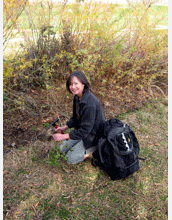Multimedia Gallery
BHSU Herbarium Database Project (Image 1)
BHSU Herbarium Database Project (Image 1)
Grace Kostel, Herbarium manager at Black Hills State University (BHSU), is shown here at work on one of several current floristic projects at the Herbarium. Grace is currently working on the flora of Harding County, SD, which was last studied in 1914. Information gained from this project will reveal species that have either been introduced or disappeared since that time.
A Herbarium is a collection of dried plants mounted, labeled and systematically arranged for use in scientific study. At present, the BHSU Herbarium holds over 30,000 specimens of vascular plants from around the globe, as well as the world's most extensive collection of Black Hills plants. The holdings of the Herbarium include approximately a thousand specimens of macrofungi, lichens and slime molds. Most of the specimens are state records, and are frequently the only records of fungi from the region. Some specimens are over 100 years old, and provide a good record of changes in biodiversity, as well as a storehouse of genetic information.
The BHSU Herbarium is also home to several thousand specimens of fossil plants, especially fossils from the Great Plains of North America, including a number of type collections. These fossils contribute to our knowledge of past environments and provide a record of climate changes over the last 30 million years.
This research was supported by National Science Foundation grant DBI 05-45102, awarded for the construction of a database of vascular plant specimens contained in 16 Herbaria from western South Dakota and eastern Wyoming. The grant also supported the purchase and installation of mobile storage units and cabinets. (Date of Image: 2007) [One of 4 related images. See Next Image.]
Credit: Mark Gabel, Black Hills State University
Images and other media in the National Science Foundation Multimedia Gallery are available for use in print and electronic material by NSF employees, members of the media, university staff, teachers and the general public. All media in the gallery are intended for personal, educational and nonprofit/non-commercial use only.
Images credited to the National Science Foundation, a federal agency, are in the public domain. The images were created by employees of the United States Government as part of their official duties or prepared by contractors as "works for hire" for NSF. You may freely use NSF-credited images and, at your discretion, credit NSF with a "Courtesy: National Science Foundation" notation.
Additional information about general usage can be found in Conditions.
Also Available:
Download the high-resolution JPG version of the image. (6 MB)
Use your mouse to right-click (Mac users may need to Ctrl-click) the link above and choose the option that will save the file or target to your computer.



